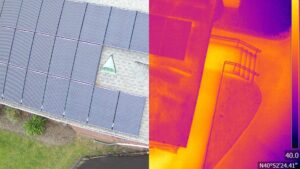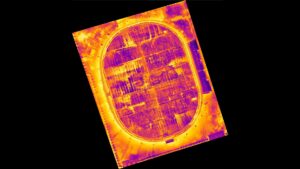Aerial Thermography for Critical Infrastructure: Finding Problems Before They Escalate
 Aging infrastructure presents significant risks for utility companies, public works departments, and engineering teams. Many assets such as bridges, pipelines, and substations operate for decades before replacement. Hidden problems often remain undetected until they lead to failures or costly emergency repairs.
Aging infrastructure presents significant risks for utility companies, public works departments, and engineering teams. Many assets such as bridges, pipelines, and substations operate for decades before replacement. Hidden problems often remain undetected until they lead to failures or costly emergency repairs.
Ground inspections, while necessary, can be time-consuming and may not capture every issue. At AeroSpect, we use aerial thermography to provide a faster, more complete view of critical infrastructure so organizations can address problems before they escalate.
How Aerial Thermography Enhances Infrastructure Monitoring
Aerial thermography allows our teams to identify signs of deterioration that are not visible with the naked eye. By capturing infrared images from above, we can spot temperature variations that indicate structural issues. This is especially valuable for bridges and roadways, where moisture intrusion or material delamination can weaken components over time. Early detection gives agencies the opportunity to plan repairs before serious damage occurs.
Thermal imaging also benefits electrical utilities. Our drones can detect overheating transformers, faulty electrical connections, or other irregularities at substations. Identifying these issues in advance reduces the risk of service interruptions and helps avoid dangerous equipment failures.
Pipeline and Water System Applications
Underground pipelines present unique challenges for inspectors. Traditional methods to locate leaks or weak spots often require digging, which is expensive and disruptive. Aerial thermography provides a better solution. By observing temperature anomalies from above, we can help locate underground leaks more quickly and with greater accuracy.
This approach allows municipalities and utility providers to reduce water loss, cut repair costs, and limit the amount of excavation required. By isolating problem areas sooner, agencies can direct resources to the sections of pipe most in need of attention rather than inspecting miles of line unnecessarily.
Benefits Over Manual Inspections
Manual inspections are essential but have limitations. They require crews to physically access hard-to-reach areas, which increases risk and lengthens the timeline for evaluation. Drones equipped with thermal cameras offer an efficient alternative. They can cover large areas in a single session and collect data from locations that might be dangerous or inaccessible to staff.
Another advantage is that aerial thermography does not require shutting down services. We can gather the necessary data while bridges remain open, substations stay operational, and water systems continue to function. This reduces disruption to the public and eliminates the costs associated with taking assets offline during inspections.
Emergency Response Scenarios
Aerial thermography also plays an important role in emergency response. After major storms, floods, or earthquakes, agencies need a clear picture of which assets have been damaged. Deploying ground crews to each site can take days, delaying the restoration process.
Our drones can be dispatched immediately to evaluate infrastructure in affected areas. Thermal imaging helps identify compromised bridges, flooded substations, or leaking pipelines quickly. This information allows leaders to prioritize repairs, allocate resources effectively, and restore service to the community faster.
Data Integration With Asset Management Platforms
 The data we capture is only as useful as the way it can be applied. AeroSpect delivers GIS-ready files and detailed reports designed to integrate with existing municipal and utility asset management systems. Our visuals can be combined with other data sets to build a comprehensive view of network health.
The data we capture is only as useful as the way it can be applied. AeroSpect delivers GIS-ready files and detailed reports designed to integrate with existing municipal and utility asset management systems. Our visuals can be combined with other data sets to build a comprehensive view of network health.
This integration allows agencies to track trends over time, prioritize repairs based on risk, and create budgets with greater accuracy. Leaders gain the ability to plan for maintenance and replacement proactively instead of reacting to failures as they occur.
Why AeroSpect Is the Right Choice
AeroSpect has extensive experience supporting both public and private infrastructure projects. Our FAA-certified pilots and ITC-certified thermographers understand the complexities of working in urban and rural environments. We use advanced thermal cameras capable of detecting even subtle temperature differences that may indicate trouble.
Our teams work closely with engineers and asset managers to develop inspection plans that fit each organization’s needs. Whether the focus is on bridges, substations, pipelines, or a combination of assets, we deliver high-quality data in a format that decision-makers can use immediately. Clients trust us to provide reliable results that help them protect their infrastructure and budgets.
A Proactive Approach to Asset Management
Infrastructure problems rarely appear overnight. Small issues build over time until they compromise service and safety. Aerial thermography gives agencies the tools to find these issues early and take action before they grow into larger, more expensive failures.
If your organization is ready to adopt a more proactive approach, AeroSpect can help. Our aerial thermography services are designed to give you a complete picture of your assets quickly, safely, and with minimal disruption. Contact us at info@aerospectny.com or call 718-551-3363 to schedule a consultation. We will work with you to create an inspection program that fits your needs and helps maintain the reliability of your critical infrastructure.
